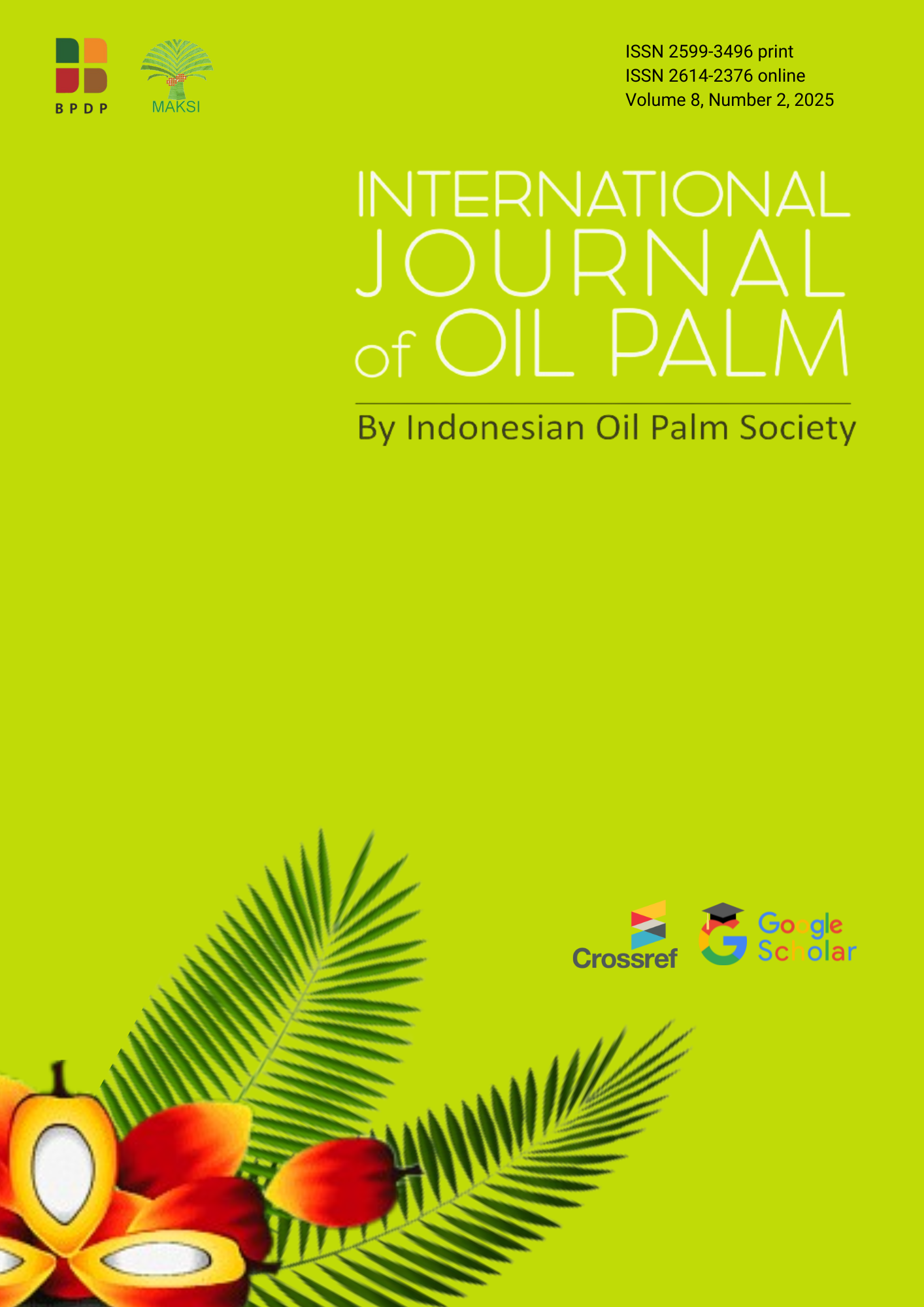The Effect of Organic and Biological Fungicides on the Development of Ganoderma Fruiting Bodies
DOI:
https://doi.org/10.35876/ijop.v8i1.143Keywords:
fruiting body development, saprof, Ganoderma sp.Abstract
Ganoderma sp. is the main pathogen of oil palm that also attacks other plants such as rubber, eucalyptus, and acacia. Aside from being a pathogen, this fungus also lives saprobically. This study aims to examine the effect of organic fungicide on the growth of Ganoderma mycelia in vitro using Petri dish and the effect of organic fungicide and biofungicide on the development of Ganoderma fruiting bodies that grow on dead breadfruit trees. In testing on breadfruit wood, organic fungicide was given two times while for biological fungicide only one application for 3 consecutive days. The organic fungicide tested was effective in killing the growth of Ganoderma mycelium in vitro. The field test showed that after three weeks of organic fungicide application, the growth of fruiting bodies was inhibited while the control continued to develop and appeared enlarged. The growth of fruiting bodies treated continued to be inhibited until the second application of organic fungicide and this condition continued after application of trichoderma as biofungicide. At H65, there was higher population of bacteria on the control compared to treated fruiting bodies. On the 104th day, it can be isolated Ganoderma from the control but not from the treated fruiting bodies. These indicate that application of organic fungicide within 26th days has inhibited the growth of fruiting bodies and at 3.5 months, Ganoderma died. After 26th days of fruiting bodies breaking, there is new fruiting bodies from breadfruit wood control but not from the treated. This organic fungicide test needs to be specifically carried out again on fruiting bodies that grow on living plant stems to asses the effectivity as organic fungicide.
Downloads
References
An Xiao-Ya, Guo-Hui Cheng, Han-Xing Gao, Xue-Fei Li,Y. Yang, D. Li , and Yu Li J. 2022. Phylogenetic Analysis of Trichoderma Species Associated with Green Mold Disease on Mushrooms and Two New Pathogens on Ganoderma sichuanense by Fungi 8(7), 704. DOI: https://doi.org/10.3390/jof8070704.
Bijalwan A., K. Bahuguna, A. Vasishth, A.Singh, S. Chaudhary, A.Dongariyal, T. K. Thakur, S. Kaushik, M.J. Ansari, S. Alfarraj, S. A. Alharbi,M.Skalicky, M. Bresti. 2021. Growth Performance of Ganoderma lucidum Using Billet Method in Garhwal Himalaya, India. Saudi Journal of Biological Sciences 28, 2709–2717.
Elkhateeb WA and Daba GM. 2022. The Precious Ganoderma Mushroom and Plant Diseases. J Microbiol Biotechnol, 7(4): 000241.
Govender, N. T, M. Mahmood, I. A. Seman and W. Mui-Yun. 2016. Basidiospore and Protoplast Regeneration from Raised Fruiting Bodies of Pathogenic Ganoderma boninense. Polish Journal of Microbiology. DOI: 10.5604/17331331.1215619.
Herliyana, E. N.,D. Taniwiryono , dan H.Minarsih. 2012. Penyakit Akar Ganoderma sp. pada Sengon di Jawa Barat dan Jawa Timur. JMHT Vol. (2): 100-109. EISSN: 2089-2063 DOI: 10.7226/jtfm.18.2.100 XVIII.
Hushiarian, R.; Yusof, N.A.; Dutse, S.W. 2013. Detection and Control of Ganoderma boninense: Strategies and Perspectives. SpringerPlus, 2-555. DOI: 10.1186/2193-1801-2-555.
Jazuli , N.A., A Kamu, K. P. Chong, D. Gabda, A. Hassan, I A Seman, C.M. Ho. 2022. A Review of Factors Affecting Ganoderma Basal Stem Rot Disease Progress in Oil Palm. Plants 2022, 11(19), 2462. DOI: https://doi.org/10.3390/plants11192462.
Miron, T., A. Rabinkov, D. Mirelman, M. Wilchek, L. Weiner. 2000. The Mode of Action of Allicin: Its Ready Permeability Through Phospholipid Membranes May Contribute to Its Biological Activity. Biochimica et Biophysica Acta 1463. DOI: 10.1016/s0005-2736(99)00174-1.
Mohammed C.L., A. Rimbawanto, D.E. Page. 2014. Management of Basidiomycete Root- and Stem-Rot Diseases in Oil Palm, Rubber and Tropical Hardwood Plantation Crops. Forest Pathology. DOI:10.1111/efp.12140.
Muraguchi H, Umezawa K, Niikura M,Yoshida M, Kozaki T, Ishii K, et al. (2015) Strand-Specific RNA-Seq Analyses of Fruiting BodyDevelopment in Coprinopsis cinerea. PLoS ONE10(10): e0141586. DOI:10.1371/journal.pone.014158.
Pilz, D. and Molina, R. 2002. Commercial Harvests of Edible Mushrooms from The Forests of The Pacific Orthwest, United States: Issues, Management, and Monitoring for Sustainability. Forest Ecology & Management 155:3-16. DOI: http://dx.doi.org/10.1016/S0378-1127(01)00543-6.
Rees, R.W.; Flood, J.; Hasan, Y.; Potter, U.; Cooper, R.M. 2009. Basal Stem Rot of Oil Palm (Elaeis guineensis); Mode of Root Infection and Lower Stem Invasion by Ganoderma boninense. Plant Pathology. 58, 982–989.
Sarfraz, M., M. J. Nasim, C. Jacob, M. C. H. Gruhlke. 2018. Efficacy of Allicin against Plant Pathogenic Fungi and Unveiling the Underlying Mode of Action Employing Yeast Based Chemogenetic Profiling Approach. Appl. Sci. 2020, 10(7), 2563. DOI: https://doi.org/10.3390/app10072563.
Slusarenko, A. J. A. Patel, D. Portz. Sustainable Disease Management in A European Context pp 313–322 Control of Plant Diseases by natural Products: Allicin from Garlic as A Case Study. European Journal of Plant Pathology 121(3):313-322. DOI:10.1007/s10658-007-9232-7.
Turner, P. Oil Palm Diseases and Disorders. Brittonia 1982, 34, 364.
Victor, D. and J. A. Omidiora. 2019. Combination of Biological Control Agents and Garlic (Allium Sativum) Extract in Reducing Damping-Off Disease of Tomato. Bangladesh Journal of Agricultural Research 44(3):553-567. DOI:10.3329/bjar.v44i3.43485.
Widiastuti, H., Santoso, D., Eris, D.D. 2016. Potensi Fungisida Organik untuk Pengendalian Ganoderma pada Tanaman Kelapa Sawit. Menara Perkebunan Vol. 84 No.2 (2016) DOI: https://doi.org/10.22302/iribb.jur.mp.v84i2.223
Yen, L.K., N S. Ali. 2022. Championing Sustainable Treatment of Oil Palm Basal Stem Rot Desease via Biological Control Agent. Journal of Oil Palm Research Vol. 34 (3) September 2022 p. 401-410 DOI: https://doi.org/10.21894/jopr.2021.0003.
Downloads
Published
How to Cite
Issue
Section
Citation Check
License
Copyright (c) 2025 Happy Widiastuti

This work is licensed under a Creative Commons Attribution-ShareAlike 4.0 International License.




